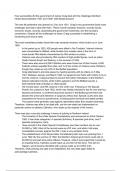How successfully did the government of James Craig deal with the challenges Northern
Ireland faced between 1921 and 1925? (20) (Modal answer)
The new NI parliament was opened on 21st June 1921. Criag’s new government faced many
challenges and had to deal with them. These include sectarian tensions, security issues,
economic issues, security, assembling the government machinery, and the boundary
commission. Despite all the challenges he faced, Craig succeeded in establishing a
functioning and secure state.
The most immediate problem faced then was sectarian tensions, which broke out in June
1920.
- In the period up to 1922, 428 people were killed in 'the Troubles'. Internal violence
was concentrated in Belfast, while threats from outside came in the form of
cross-border IRA attacks characterised by IRA arracks on police.
- Violence was also provoked by IRA murders of high-profile figures, such as police
chiefs Colonel Smyth and Swanzy, in the summer of 1920.
- There were also around 8,000 Catholics who were forced out of their homes, 6,000
Catholic workers expelled from jobs, and ⅔ of the victims of violence were Catholics,
though they made up only 23% of the Belfast population.
- Craig attempted to promote peace by meeting secretly with de Valera on 5 May
1921. Between January and March 1922, he agreed to two Pacts with Collins to try to
end the violence. Craig promised to prevent the further intimidation of the Northern
Ireland nationalist minority, while Collins agreed to end the Belfast boycott, a
Dail-imposed trade embargo on Ulster goods.
- Yet it broke down, and IRA violence in the north rose. Following is The Special
Powers Act, passed in April 1922, which was initially intended to last for one year but
became permanent. It conferred draconian powers in the Belfast government and
allowed the arrest and detention of suspects without trial. Special courts were also
empowered to hand out punishments, including penal servitude and death penalty.
The powers were generally used against nationalists rather than loyalist extremists.
Therefore, violence was able to be dealt with, yet the new state had implemented no
particular actions to address Catholics, who made up the majority of the victims.
There was also a security challenge in terms of policing in Northern Ireland.
- The formation of the Ulster Special Constabulary was announced on 22nd October
1920. It has three categories: A specials (full-time), B specials (part-time), and C
specials (emergency men).
- New recruits to the Ulster Special Constabulary saw their numbers rise to over
30,000 by 1922. Most of the recruits were ex-UVF men, and while it did enjoy
considerable success against the IRA, it was a very sectarian force.
- The establishment of the Royal Ulster Constabulary later took over policing from 1
June 1922. By the summer of 1922, the Northern Ireland government could call on
50,000 full and part-time police officers. However, while it was hoped that it would be
an impartial force, Catholics would make up one-third of this force. This did not
happen, and it became identified with a group made up of ex-RIC men.
Therefore, while policing was able to be established, the new state again failed to
acknowledge Catholics.




